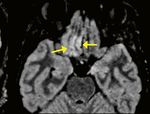MRI Depicts Olfactory Bulbs and Cortical Involvement in COVID-19 Patients with Anosmia
←
→
Page content transcription
If your browser does not render page correctly, please read the page content below
MAGNETOM Flash (78) 1/2021 Neurologic Imaging · Clinical
MRI Depicts Olfactory Bulbs and
Cortical Involvement in COVID-19 Patients
with Anosmia
Letterio S. Politi, M.D.1,2; Marco Grimaldi, M.D.1; Luca Balzarini, M.D.3
1
Department of Neuroradiology, IRCCS Humanitas Research Hospital, Rozzano, Milan, Italy
2
Department of Biomedical Sciences, Humanitas University, Pieve Emanuele, Milan, Italy
3
Department of Radiology, IRCCS Humanitas Research Hospital, Rozzano, Milan, Italy
Abstract Key points
Anosmia and ageusia are very common symptoms • In COVID-19 patients presenting with anosmia, T2-
in SARS-CoV-2 infections. Here we present magnetic FLAIR hyperintensity can be depicted in the olfactory
resonance imaging evidence of brain signal alterations bulbs and anterior piriform cortex, suggesting possi-
in the olfactory bulbs and the piriform cortex, presum- ble viral invasion of the brain.
ably caused by SARS-CoV-2. • The signal alteration is reduced when patients
recover from the symptoms.
• Anosmia can be the predominant COVID-19 mani-
festation, and this should be taken into account
when identifying and isolating infected patients in
order to avoid disease spread.
The neurotropism of human coronaviruses has already using a 1.5 Tesla scanner (MAGNETOM Aera, Siemens
been demonstrated in small animals [1]. In autoptic Healthcare, Erlangen, Germany) equipped with a 20-
studies, the severe acute respiratory syndrome coronavirus channel phase array head and neck coil. On 2D and 3D
(SARS-CoV), which was responsible for the SARS outbreak fluid-attenuated inversion recovery (FLAIR) images,
in 2002–2003, was found in the brain of infected patients hyperintensity was evident in the bilateral olfactory bulbs
[2]. It has been proposed that the neuroinvasive potential (red arrows) and in the right rectus gyrus (yellow arrows).
of the novel SARS-CoV-2 virus, which causes coronavirus This signal alteration in the cortex of the brain area that
disease 2019 (COVID-19), might be at least partially is responsible for olfaction is highly suggestive of viral
responsible for respiratory failure in COVID-19 patients [3]. infection. Since many patients in the Italian outbreak
In this paper, we will share magnetic resonance imaging complain of anosmia [4], a swab was performed and
(MRI) evidence of in vivo brain alteration presumably RT-PCR analysis was positive for COVID-19. In a follow-up
caused by SARS-CoV-2, and we will stress that anosmia MRI performed 28 days later, the signal alteration had
can be the predominant symptom of COVID-19. almost completely disappeared and the patient had recov-
A 25-year-old female radiographer with no significant ered from anosmia.
prior medical history who had been working in a COVID-19 Similar but less-obvious MRI findings were depicted
ward presented with a mild dry cough that lasted for one in a 39-year-old female COVID-19 patient who presented
day. This was followed by persistent and severe anosmia only with anosmia. In this case, the brain MRI was per-
and ageusia. She was always nonfebrile. Three days later, formed eight days after symptom onset. Furthermore,
a nasal fibroscopy was unremarkable, and non-contrast no brain abnormalities were seen in two other patients
chest and maxillofacial computed tomography were nega- who presented with anosmia and underwent an MRI exam
tive. On the same day, a brain MRI was also performed, at 12 and 25 days from symptom onset, respectively.
siemens-healthineers.com/magnetom-world 43Clinical · Neurologic Imaging MAGNETOM Flash (78) 1/2021
1A Here we report on human brain involvement in patients
who tested positive for COVID-19. We show signal alter-
ations that are consistent with viral brain invasion in
regions that are congruent with the patients’ symptoms.
It should be noted that the posterior part of the gyrus
rectus and medial orbital gyrus encompasses the so-called
anterior piriform cortex, which receives input from the
olfactory bulb through the lateral olfactory tract. The ante-
rior piriform cortex and the posterior piriform cortex (the
latter is located in the temporal lobe) are considered the
most important olfactory cortical areas. Curiously, in hu-
mans, the anterior piriform cortex seems to play a crucial
role in encoding the difference between groups of odors.
In anosmic animals like the dolphin, this entry zone is
so undeveloped and flat that Broca called the area the
“olfactory desert” (désert olfactif) [5].
Although the presence of SARS-CoV-2 in the cortical
1B
FLAIR hyperintense areas is not demonstrated by the MR
images, we believe that the congruence between the
clinical manifestations in our patient (i.e., olfactory
dysfunction) and the cortical brain MRI abnormalities is
highly suggestive of possible viral invasion; similar focal
abnormalities are definitely unusual and alternative
diagnoses are very difficult to find, especially in the clinical
setting of anosmia (for instance, anti-NMDAR encephalitis
can cause transient FLAIR hyperintensities, but the clinical
manifestations rule out this entity; status epilepticus may
cause transient gyral edema with T2-FLAIR hyperintensity,
but olfactory aura continua / simple partial status epilepti-
cus is exceptional, typically originates from the mesial
temporal lobe, and causes olfactory hallucinations but not
loss of smell). By contrast, viral infections are commonly
considered potential causes of transient or permanent
1C
sensorineural olfactory dysfunctions. In the presented
cases, no analysis of cerebrospinal fluid (CSF) was per-
formed; however, it should be noted that the clinical
sensitivity of CSF analysis with molecular testing for
intraparenchymal brain diseases remains undefined
(with the exception of herpes simplex (HSV) encephalitis),
negative results may not exclude infection, and in some
cases cerebral biopsy may be necessary to confirm the
diagnosis. Overall, we believe that the abovementioned
MRI findings support the hypothesis that the SARS-CoV-2
virus can invade the brain. Based on the MRI findings, our
hypothesis is that, following initial replication in the nasal
mucosa, SARS-CoV-2 may, as is the case with other corona-
viruses, spread from the olfactory epithelium to the olfac-
tory bulb, and subsequently to the posterior gyrus rectus
1 Brain MRI alterations in a COVID-19 patient presenting with through the lateral olfactory tract [1, 2].
anosmia (three days after symptom onset). Overall, the presence of MRI abnormalities in the
Coronal 2D FLAIR (1A, B) and axial reformatted 3D FLAIR images
posterior part of the gyrus rectus could conceivably be
showing hyperintensity in bilateral olfactory bulbs (red arrows)
and in the right rectus gyrus (yellow arrows).
related to the centripetal spreading of SARS-CoV-2 through
the lateral olfactory tract, and the olfactory dysfunction
experienced by our patient may have a sensorineural
44 siemens-healthineers.com/magnetom-worldMAGNETOM Flash (78) 1/2021 Neurologic Imaging · Clinical
origin. Our own and others’ observations of normal References
brain imaging in subjects with COVID-19-related olfactory 1 Dubé M, Le Coupanec A, Wong AHM, Rini JM, Desforges M,
dysfunctions [6], and the disappearance of the MRI abnor- Talbot PJ. Axonal Transport Enables Neuron-to-Neuron Propagation
malities in a follow-up study in one of our patients suggest of Human Coronavirus OC43. J Virol. 2018;92(17):e00404–18.
that these imaging changes might not always be present 2 Gu J, Gong E, Zhang B, Zheng J, Gao Z, Zhong Y, et al.
Multiple organ infection and the pathogenesis of SARS.
in COVID-19, or are limited to the very early phase of
J Exp Med. 2005;202(3):415–24.
the infection. Further, anosmia can be the predominant 3 Li YC, Bai WZ, Hashikawa T. The neuroinvasive potential of
COVID-19 manifestation, and this should be taken into SARS-CoV2 may play a role in the respiratory failure of COVID-19
account when identifying and isolating infected patients patients. J Med Virol. 2020;92(6):552–555.
in order to avoid disease spread. 4 Giacomelli A, Pezzati L, Conti F, Bernacchia D, Siano M, Oreni L,
et al. Self-reported Olfactory and Taste Disorders in Patients With
Severe Acute Respiratory Coronavirus 2 Infection: A Cross-sectional
Acknowledgments Study. Clin Infect Dis. 2020;71(15):889–890.
5 Schiller F. A memoir of olfaction.
We are grateful to Simona Superbi for providing us J Hist Neurosci. 1997;6(2):133–46.
with technical support. 6 Eliezer M, Hautefort C, Hamel AL, Verillaud B, Herman P, Houdart E,
et al. Sudden and Complete Olfactory Loss of Function as a Possible
Symptom of COVID-19.
JAMA Otolaryngol Head Neck Surg. 2020;146(7):674–675.
Contact
Letterio S. Politi, M.D.
Department of Neuroradiology
IRCCS Humanitas Research Hospital
Via Alessandro Manzoni 56,
Rozzano (MI), 20089
Italy
letterio.politi@hunimed.eu
Luca Balzarini, M.D. Marco Grimaldi, M.D. Letterio S. Politi, M.D.
Advertisement
View one of our most popular sessions
from the 11th MAGNETOM World Summit: Quantitative, Robust Neuro MRI
Multi-parametric MRI in Stroke Imaging
Shan Shan Lu (First Affiliated Hospital of Nanjing Medical University,
Nanjing, Jiangsu, China)
Clinical Benefits of MR Fingerprinting1
Meiyun Wang (Henan People’s Hospital, China)
MRI Techniques in Multiple Sclerosis:
New Diagnostic and Research Developments
Matilde Inglese (Università degli Studi di Genova, Italy)
Morphometry. Measuring Brain Maturation with Quantitative MRI
Baptiste Morel (Service de Radiologie Pédiatrique, Hopital Clocheville,
CHRU, Tours, France)
Wave CAIPI for Routine Clinical Brain MRI
Susie Huang (Massachusetts General Hospital, Boston, MA, USA)
Clinical Translation of 7T MRI: Epilepsy Imaging
Srinivasan Mukundan (Brigham and Women’s Hospital, Boston, MA, USA)
Siemens-Healthineers.com/MWS2020-recordings
Graphic recording: www.gabriele-heinzel.com
1
R Fingerprinting is not commercially available in some countries. Due to regulatory reasons its future availablility cannot be ensured.
M
Please contact your local Siemens Healthineers organization for further details.
siemens-healthineers.com/magnetom-world 45You can also read
























































